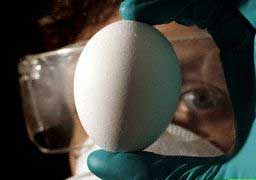Testing H5N1 vaccine in Australia
A H5N1 vaccine from CSL Ltd. in Australia gave promising results when tested in small doses on adults. The statement was made on February 17.
 Chicken eggs are used to produce vaccines (Photo: VNN) The test results on 400 healthy adults, from 18 to 45 years old, showed that the vaccine produced an immune response strong enough to protect about 200 people. Side effects such as hand pain and mild fever are negligible.
Chicken eggs are used to produce vaccines (Photo: VNN) The test results on 400 healthy adults, from 18 to 45 years old, showed that the vaccine produced an immune response strong enough to protect about 200 people. Side effects such as hand pain and mild fever are negligible.
The tested dose was 15 micrograms of H5N1 antigens and aluminum phosphate excipients to boost the immune response. It is known that other companies have found a better immune response when using other types of excipients. However, aluminum-based excipients are the only additives that are registered for use worldwide.
CSL hopes its sample vaccine will be approved by the end of 2006 after completing the trial at 30 and 45 micrograms per 800 people. These people are between 6 months and very old.
Also according to CSL, it is not known how effective their vaccine is against the mutant H5N1 strain into a form that easily spreads between people and people.
As recommended by a group of experts, vaccination of humans or poultry against an H5N1 strain cannot protect them against other H5N1 strains. Many H5N1 strains should be used to produce vaccines and vaccines. continue to renew those vaccines.
The H5N1 strain that CSL uses is taken from a patient in Vietnam. This strain is developed and distributed by the World Health Organization. After that, CSL cultivates viruses in chicken eggs and the process of creating vaccines is similar to regular flu vaccines.
The company said there are no plans to produce vaccines according to other methods. Some other companies are now trying methods such as cell culture. Until now the cell culture method has proved to be able to produce vaccines faster than the method of using chicken eggs.
Minh Son (According to Reuters)
- Vietnam produces H5N1 vaccine for poultry
- The United States is about to test a vaccine against HIV in humans
- March 2012: Launching H5N1 vaccine for poultry
- Nha Trang vaccine institute produces H5N1 vaccine
- Hungary prepared the vaccine against H5N1 virus
- No vaccine against H5N1 has been detected in Vietnam
- Glaxo has a vaccine against H5N1
- The US began testing Zika vaccine on humans
- Australia prepares vaccine for influenza A / H1N1
- Injecting two trials of H5N1 vaccine made in Vietnam
- Successful production of H5N1 vaccine
- US aids Vietnam to develop H5N1 flu vaccine
 March 2012: Launching H5N1 vaccine for poultry
March 2012: Launching H5N1 vaccine for poultry Experts comment on the mysterious gradual disappearance of the Delta variant in Japan
Experts comment on the mysterious gradual disappearance of the Delta variant in Japan Danger of the two Delta . branch variants
Danger of the two Delta . branch variants 2020 pandemic flu attack humans?
2020 pandemic flu attack humans?